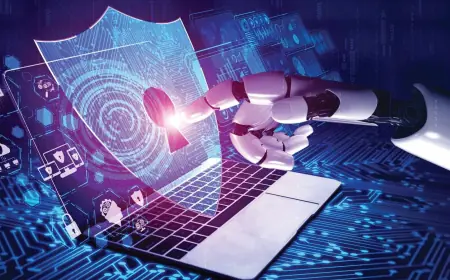How Do Chatbots Work?
Discover how chatbots work, their technology, and how they enhance communication with AI-driven responses.
Chatbots are revolutionizing how businesses and individuals interact with technology. They provide an automated, conversational interface between users and computer systems, enabling efficient, real-time communication. Whether handling customer service inquiries, providing product recommendations, or even engaging in more niche interactions like those found on AI sexting websites, chatbots are becoming a staple in the modern digital landscape.
Understanding how chatbots work is crucial to appreciating their functionality and potential. Chatbots are powered by a combination of technologies like natural language processing (NLP), machine learning, artificial intelligence (AI), and sometimes pre-defined rules or scripts. In this article, we'll break down how chatbots function, explore the technology behind them, and discuss their applications across various industries.
What Is a Chatbot?
A chatbot is an AI-powered tool designed to simulate conversations with users. Chatbots can interact via text, voice, or even more advanced multimodal interfaces. They have become increasingly common in applications ranging from customer service to online shopping assistants and specialized services like AI chatbot 18 platforms, which cater to adults seeking customized, AI-driven conversations.
There are two main types of chatbots: rule-based chatbots and AI-powered chatbots.
-
Rule-Based Chatbots: These chatbots operate on predefined flows and scripts. They follow specific rules programmed by developers, often leading users through step-by-step processes. They are good for simple, structured interactions but lack the flexibility of advanced AI chatbots.
-
AI-Powered Chatbots: These chatbots use machine learning, natural language processing (NLP), and sometimes deep learning algorithms to understand user input, predict intent, and respond in a more fluid, conversational manner. They continuously learn and improve their responses over time, offering a more dynamic interaction than rule-based bots.
How Do Chatbots Work?
1. Input Recognition (Understanding User Queries)
The first step in a chatbot’s operation is understanding what the user wants. Chatbots begin by processing the user input, which can be in the form of text or voice. Advanced chatbots use NLP to break down the input into meaningful components.
-
Natural Language Processing (NLP): NLP is a key technology in chatbot development, allowing bots to interpret and understand human language. It breaks down a user's message into components such as intents (the goal of the message) and entities (specific details within the message). For example, in an e-commerce chatbot scenario, if a user types, “Show me the latest laptops under $500,” the chatbot would identify “laptops” as the product and “$500” as the price limit, while understanding the overall intent is to browse products.
-
Speech Recognition: For voice-based chatbots, speech recognition converts spoken words into text that the chatbot can understand. This is especially common in chatbots like Google Assistant or Amazon Alexa, where users interact via voice commands.
2. Processing the Input (Determining Intent)
Once the chatbot understands the user’s input, it moves on to determining the intent behind the message. This involves analyzing the context of the conversation and deciding how to respond.
-
Intent Recognition: Chatbots use algorithms to predict the user’s intent from their message. These algorithms can be based on machine learning models trained on large datasets. The chatbot uses this understanding to determine how to respond, what information to provide, or what actions to take.
-
Predefined Rules (In Rule-Based Bots): In rule-based chatbots, responses are determined based on fixed rules. These bots work like decision trees, where the chatbot follows a predefined path based on the user's answers. This makes them useful for FAQ systems or basic customer support queries but limits their flexibility in handling complex or nuanced conversations.
3. Generating a Response (Conversing with the User)
After processing the input and determining the intent, the chatbot must generate an appropriate response. There are different ways chatbots produce responses depending on their complexity.
-
Scripted Responses (For Rule-Based Chatbots): In rule-based chatbots, responses are pre-written and chosen based on user input. For example, if a user asks about shipping policies, the chatbot will display the relevant pre-programmed response.
-
Dynamic Responses (For AI-Powered Chatbots): AI chatbots generate responses in real-time based on the input they receive. They use machine learning algorithms and natural language generation (NLG) to create sentences that feel natural and relevant to the conversation. AI chatbots continually improve their responses as they interact with more users, learning to adjust tone, context, and content dynamically.
-
Contextual Conversations: Advanced AI chatbots remember past interactions and use contextual data to make conversations more meaningful. For example, if a chatbot remembers that you ordered pizza last week, it might ask if you want to reorder the same item.
4. Learning from Interactions (Improving Over Time)
Machine learning plays a crucial role in how AI chatbots improve over time. AI-powered chatbots don’t just respond based on predefined rules; they learn from each interaction and become better at understanding user behavior.
-
Training Data: AI chatbots are initially trained on vast amounts of conversation data to understand common user queries and intents. Over time, they collect more data from their interactions, allowing them to refine their responses and improve accuracy.
-
Feedback Loops: Many chatbots incorporate feedback loops, where they ask users if their responses were helpful. Based on user feedback, chatbots can adjust future responses to align more closely with user expectations.
For example, chatbots used in customer service settings can learn from failed or incomplete interactions to understand why a particular response was unsatisfactory. With this information, the chatbot can adjust and avoid repeating the same mistakes.
Applications of AI Chatbots
Chatbots have applications across various industries, from mainstream businesses to niche markets. Below are some common uses of AI chatbots:
1. Customer Service
Customer service is one of the most common applications for AI chatbots. Businesses use chatbots to answer FAQs, troubleshoot common issues, and assist customers with their inquiries. Chatbots can significantly reduce the load on human customer service agents, handle a large number of interactions at once, and provide instant responses.
For instance, retail companies deploy AI chatbots to help customers track orders, inquire about products, or process returns. Chatbots ensure that customers receive prompt responses without needing to wait for a human agent.
2. E-commerce and Sales
In the e-commerce sector, AI chatbots function as virtual sales assistants. They help users browse products, answer product-specific questions, and even make personalized recommendations based on user preferences and past purchases. This improves the shopping experience and increases the likelihood of conversions.
AI chatbots in e-commerce are often integrated with websites, messaging platforms, and apps, making them accessible from various points of interaction. They can also assist users through the checkout process, reducing cart abandonment rates.
3. Health and Wellness
AI chatbots are increasingly used in healthcare and wellness services. From booking appointments to providing information on medical conditions, chatbots are assisting both patients and healthcare professionals. Some healthcare providers use chatbots to monitor patient symptoms, track medication adherence, and provide real-time advice.
With privacy being a critical concern in healthcare, chatbots must ensure that sensitive data is handled securely. AI-powered healthcare chatbots often adhere to regulations such as HIPAA to ensure compliance with privacy laws.
4. Niche Chatbots in Adult Entertainment
While most chatbots serve mainstream industries, there is also a growing presence of chatbots in niche markets, including adult entertainment. These chatbots are designed to engage users in personalized, adult-oriented conversations.
Platforms like AI sexting websites utilize chatbots to offer intimate and interactive experiences for users seeking digital companionship. Similarly, AI chatbot 18 solutions cater to adults looking for private, AI-driven interactions that align with their specific preferences.
Chatbots in this domain can use AI to simulate lifelike conversations, offering everything from virtual intimacy to more personalized adult interactions. Some platforms are even exploring more advanced integrations, such as the incorporation of AI generated pussy pics, to provide a unique, interactive experience. This represents a new frontier in how chatbots are being used to cater to specific user needs in a discreet, customized manner.
5. Travel and Hospitality
In the travel industry, AI chatbots help customers book flights, make hotel reservations, and provide real-time travel updates. Airlines and hotel chains increasingly use chatbots to enhance customer service, answer questions about bookings, and recommend travel packages based on user preferences.
For example, a travel chatbot might assist a customer in selecting a destination based on budget, suggest activities during their stay, and provide weather or local transportation updates.
6. Finance and Banking
Banks and financial institutions use chatbots to handle customer inquiries, such as checking account balances, transferring money, or monitoring transactions. AI chatbots in this industry help streamline operations while ensuring security and compliance with financial regulations.
Chatbots in banking are also starting to incorporate more advanced features like fraud detection, where they can alert users of unusual activity on their accounts in real-time.
Conclusion
AI chatbots are versatile tools that work by combining natural language processing, machine learning, and data analytics to understand and respond to user queries. From e-commerce and customer service to niche industries like adult entertainment, chatbots are helping businesses automate tasks, engage customers, and provide more personalized experiences. Whether it’s assisting customers with purchasing decisions, providing medical advice, or even simulating intimate conversations on AI sexting websites, chatbots continue to evolve and redefine how humans interact with machines.
With the ongoing advancements in AI and natural language processing, chatbots are poised to become even more sophisticated, offering more human-like interactions and expanding into new industries. The future of chatbots promises deeper integration, better contextual understanding, and greater flexibility, making them essential tools for businesses across all sectors.
What's Your Reaction?
 Like
0
Like
0
 Dislike
0
Dislike
0
 Love
0
Love
0
 Funny
0
Funny
0
 Angry
0
Angry
0
 Sad
0
Sad
0
 Wow
0
Wow
0















































